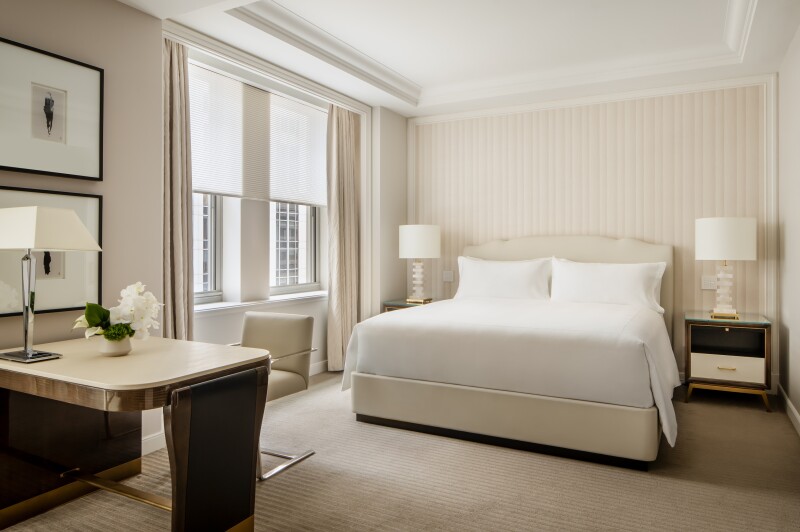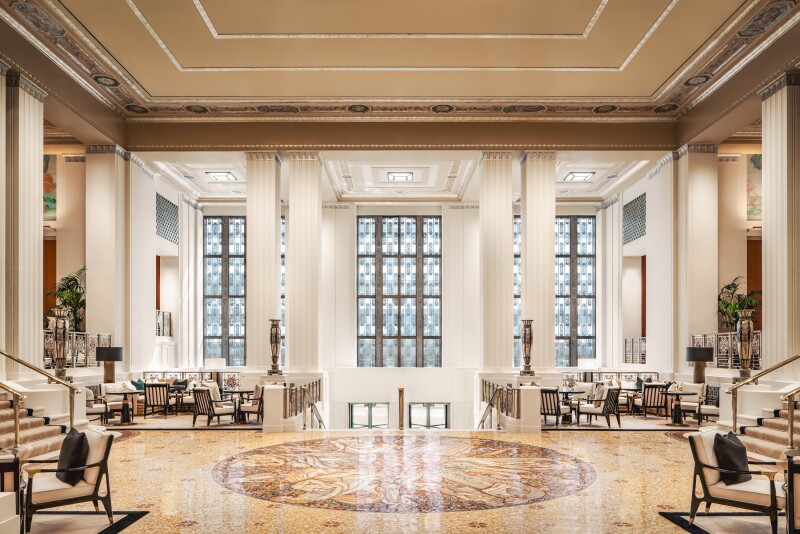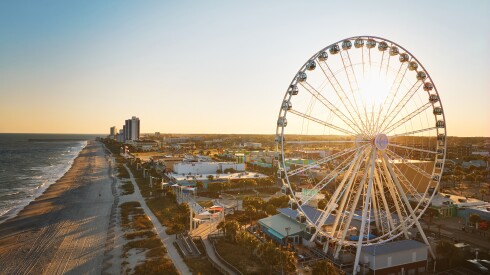New York City finally has welcomed back one of its legendary hotel darlings: the Waldorf Astoria New York. On July 15, the hotel began welcoming guests to its 375 rooms, lobby, bar, and restaurants. Over the next two months, the hotel will fully reopen when its legendary Grand Ballroom and new Guerlain Wellness Spa also become available.
“We are honored to carry forward a legacy that helped define luxury hospitality in the city for over a century. As we reopen our doors, we’re not just restoring a landmark, we’re reimagining what world-class service means in the modern era,” Luigi Romaniello, managing director of Waldorf Astoria New York, told Afar. “By blending timeless elegance with cutting-edge innovation, art deco style with contemporary touches, and original dining outlets inspired by tried-and-true Waldorf favorites, we aim to set a new standard in New York hospitality while staying true to the spirit, heritage, and grandeur that have always defined the Waldorf.”
The iconic hotel first opened in 1931 and has since hosted many celebrities, heads of states, presidents, and significant events. It closed in 2017 for much needed renovations, and its long-awaited return has been highly anticipated by New Yorkers and travelers around the globe.
Guests can now book stays in the reimagined rooms and suites, with interior designs by Pierre Yves Rochon, a French designer known for his work on the Emory Hotel in London and Four Seasons hotels around the world, including Paris, Milan, and Florence. Accommodations are larger—the hotel used to have 1,400 rooms and now is down to just 375 (plus 372 residences). Textiles include soft leather and tailored upholstery in a neutral palette, with custom furniture and artisanal hardware, and bathrooms decked out in marble. Details offer a subtle nod to the building’s art deco design, but nothing is too pronounced, with simple elegance at the forefront.

The guest rooms give a subtle nod to the building’s art deco heritage.
Photo by Joe Thomas/Courtesy of Waldorf Astoria New York
However, the hotel’s facade and public spaces exude art deco glamour. Skidmore, Owings & Merrill were the architects charged with preserving and restoring the landmarked building, both inside and out. With 62,000 square feet inside designated by the Landmarks Preservation Commission, it’s one of the largest preservation and adaptive reuse projects in New York City’s history.
The hotel brought in numerous artisans to restore everything from detailed metalwork to hand-painted murals and gold-leaf applications throughout the hotel’s interior. But they also managed to make the property more accessible for patrons with mobility challenges, create guest rooms and public areas that feel more spacious, and add more natural light.
For example, in the new reception area, the same marble used for the columns of the historic Peacock Alley bar was employed to construct the fireplace, ensuring visual continuity. Portoro marble, mosaics, and restored decorative features were preserved and repositioned to allow for modern conveniences like integrated lighting systems and automated curtains.
Guests will notice the modern era right away, starting with the doormen and staff at reception greeting them in chic, tailored uniforms by British couture designer Nicholas Oakwell. Oakwell’s NO Uniform designs were revealed to media earlier this year in a lively fashion show at the hotel.

The history and grandeur have been carefully restored in the lobby and throughout the hotel.
Photo by Joe Thomas/Courtesy of Waldorf Astoria New York
Tables are also available now for the hotel’s three food and beverage concepts: restaurant Lex Yard, the legendary Peacock Alley by chef Michael Anthony of Gramercy Tavern, and Japanese dining concept Yoshoku.
Lex Yard is Waldorf Astoria New York’s signature two-story American brasserie. Chef Anthony’s menu features dishes like the Royal Ocsiètre Gold Caviar sandwich, slow-poached halibut with borscht sauce, and a burger that’s destined to become a classic. Already a classic is the Waldorf Salad, invented here and on the menu again with subtle seasonal changes that rotate around the core of lettuce, celery, apples, grapes, and cheddar.
“To open a restaurant in such a legendary space is a dream come true. It offers a wonderful opportunity to contribute to the culinary conversation in New York and the evolving landscape of contemporary American cuisine,” said Anthony.
Peacock Alley, which links Park Avenue, Lexington Avenue, and the Library Lounge, remains the heart of Waldorf Astoria New York—and every Waldorf Astoria location around the world; each has a Peacock Alley named after the original in New York. The fully restored historic Waldorf Astoria clock, a gift from Queen Victoria in 1893, and a Steinway piano that Cole Porter played when he lived at the hotel are in prime positions here. Award-winning cocktail master Jeff Bell of the Please Don’t Tell (PDT) speakeasy worked alongside the hotel team to create the beverage programs for Peacock Alley and Lex Yard. Cocktails at Peacock Alley include the Waldorf Cocktail (rye, vermouth, and absinthe) and the 50th Street Martini, made with Tanqueray, vetiver, and dry vermouth. The food menu includes the Waldorf Salad, a seafood tower, and a lobster roll with truffles.
And then there’s Yoshoku, an intimate dining room set alongside the iconic hand-cut “Wheel of Life” mosaic by artist Louis Rigal and neoclassical murals honoring the rituals of food and gathering. Yoshoku offers a kaiseki-inspired menu reimagined through a New York lens by chef Ry Nitzkowski (of Residence of Mr. Moto). There’s a six-course tasting menu with dishes like toro tartare with caviar and King crab with Tosazu jelly as well as an à la carte option.
On September 1, the hotel’s 43,000 square feet of meeting and event spaces will open, including the legendary Grand Ballroom and Basildon, Jade, and Astor Rooms, which each feature notable design details, such as intricate crown moldings, metalworks, and frescoes. The brand-new Guerlain Wellness Spa will also open September 1.








